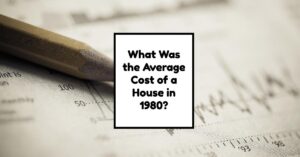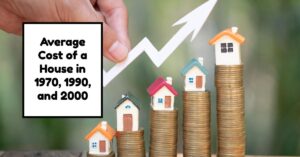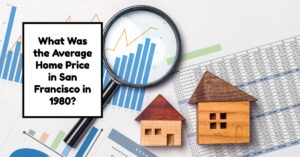
Have you ever found yourself pondering the financial decisions your parents or grandparents made when they purchased their first homes? Picture this: it’s the vibrant 1980s, a decade filled with iconic fashion trends like leg warmers and shoulder pads, and music that defined a generation.
This era, marked by economic fluctuations and cultural shifts, had a profound impact on the housing market. Can you believe the average cost of a house in 1980 was $76,375? It's crazy to think about how much things have changed, especially the price of buying a house! We're going to take a fun trip back to the 80s to see what the houses and apartments looked like back then. Get ready for some serious flashbacks!
What Was the Average Cost of a House in 1980?
Setting the Stage: The Economic Vibe of 1980
Before we delve into the specifics of housing costs, it’s essential to understand the broader economic context of 1980. The U.S. economy was grappling with severe inflation, presenting a unique and challenging environment for homebuyers. Picture this scenario: you stroll through the local grocery store, only to observe prices perpetually on the rise. In fact, by 1980, inflation had reached alarming heights, fundamentally altering consumer behavior and economic stability.
- Inflation Rates: By the end of the 1970s, inflation had jumped to about 13.5%, significantly affecting everyday expenses, from groceries to housing. This created an atmosphere where costs seemed to soar overnight, leading to a cautious approach in major purchases.
The high inflation rates forced many families to rethink their strategies when it came to buying homes. Housing became a necessity in an environment where financial confidence was shaky, affecting everything from the average house price to mortgage approvals.
The Average Cost of a House in 1980: Hold onto Your Hats!
Now, let’s get to the heart of the matter—how much did a typical house actually cost in 1980? According to the Federal Reserve Bank of St. Louis, which has meticulously documented financial trends (source: Federal Reserve Bank of St. Louis), the average sales price of a house in the United States fluctuated significantly throughout the year:
| Date | Average Sales Price |
|---|---|
| 1980-01-01 | $73,600 |
| 1980-04-01 | $74,400 |
| 1980-07-01 | $77,500 |
| 1980-10-01 | $80,000 |
Can you believe that the average house price just about breached the $80,000 mark by the end of the year? This figure seems startlingly low when compared to contemporary prices, where the cost of entry into the housing market can often exceed $300,000. However, it’s crucial to remember that incomes were considerably lower during this time period, creating a different dynamic in the housing market.
Why Was the Average House Price in 1980 So Different?
There are several key factors that explain why the average cost of a home in 1980 presents such a stark contrast to today’s averages:
- Inflation: As mentioned earlier, while prices were rising due to inflation, the increase in home prices during the 1980s didn’t match the rapid uptick seen in later decades. Consequently, homes were deemed more affordable relative to income levels at the time.
- Interest Rates: Here’s a crucial factor that changed the game entirely—mortgage interest rates in 1980 were incredibly high, peaking at over 18% at points during the decade. Imagine taking out a mortgage with such exorbitant rates! The high interest burden significantly impacted what families could afford, creating a challenging environment for potential buyers even though home prices seemed low at face value.
- Different Housing Market Dynamics: The housing market in 1980 was characterized by a lack of emphasis on luxury and size. Unlike today’s trends, where mini-mansions and high-end amenities are prioritized, homebuyers often focused on affordability and basic comfort. This cultural shift has led to a drastic change in what is perceived as desirable in real estate, influencing demand and price growth in subsequent decades.
A Blast from the Past: What Else Could You Buy in 1980?
To gain perspective on the value of $80,000 in 1980, let’s take a whimsical ride down memory lane and see what delightful purchases were possible:
- Arcade Games Galore: The 80s were the golden age of arcade gaming! Back when each play of Pac-Man cost only a quarter, your $80,000 could have afforded you an astounding 320,000 game plays!
- A Fleet of Quirky Cars: The automotive industry saw a surge of colorful, boxy designs in this decade. With the price of a new car ranging from $7,000 to $8,000, you could have bought yourself an entire fleet of flashy vehicles, giving you plenty of style on the road.
- Denim Dreams: With 1980 being an era dominated by denim, you could stock up on as much fashion as you desired. A pair of jeans cost approximately $30, so with $80,000, you could flaunt a staggering 2,666 pairs of jeans—a wardrobe reflecting the quintessential style of the 80s!
The 1980s Housing Market: A Lesson in Perspective
Reflecting on the average cost of a house in 1980 can be both shocking and enlightening. It serves as a poignant reminder of how much societal values evolve over time, influencing everything from financial choices to lifestyle preferences. The economic landscape, complementary interest rates, and the less glamorous desires in housing have all shifted dramatically.
As you listen to your parents fondly recall “the good old days” of affordable housing, remember that nostalgia often glosses over the complexities of those times. The landscape of homeownership has transformed, presenting new challenges and opportunities. Understanding the past helps us appreciate the progress made and the obstacles that still lie ahead in the ever-changing world of real estate.
Related Articles:
- Average House Price in 1950 (Compared to Today)
- Housing Market Graph 50 Years: Showing Price Growth
- Average Housing Prices by Year in the United States
- Average Home Value Increase Per Year, 5 Years, 10 Years
- San Diego Housing Market Graph 50 Years: Analysis and Trends
- How Much Did Housing Prices Drop in 2008?
- Housing Market Crash 2008 Explained: Causes and Effects
- Housing Market Predictions for Next 5 Years
- Housing Market Predictions for Next Year: Prices to Rise by 4.4%
- Housing Market Predictions for the Next 4 Years



